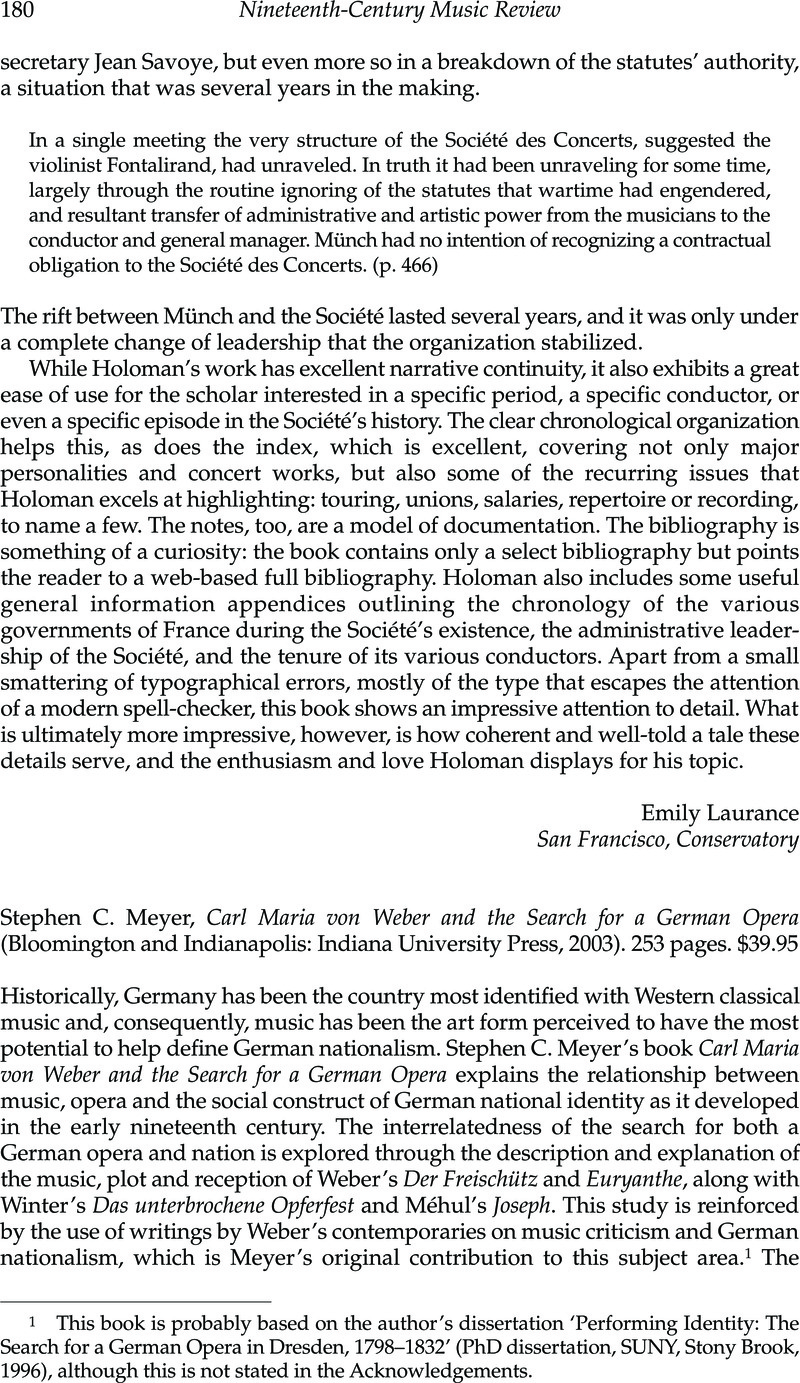No CrossRef data available.
Article contents
Stephen C. Meyer, Carl Maria von Weber and the Search for a German Opera (Bloomington and Indianapolis: Indiana University Press, 2003). 253 pages. $39.95
Published online by Cambridge University Press: 13 April 2011
Abstract

- Type
- Book Reviews
- Information
- Copyright
- Copyright © Cambridge University Press 2006
References
1 This book is probably based on the author's dissertation “Performing Identity: The Search for a German Opera in Dresden, 1798–1832’ (PhD dissertation, SUNY, Stony Brook, 1996)Google Scholar , although this is not stated in the Acknowledgements.
2 For example, Meyer's book could be described as the ‘missing’ chapter in Applegate, Celia and Potter, Pamela, eds, Music & German National Identity (Chicago: University of Chicago Press, 2002)Google Scholar , although the thesis of the latter emphasizes that it was not the composers who connected music and German nationalism but writers and other intellectuals. Warrack's, JohnGerman Opera: From the Beginnings to Wagner (Cambridge: Cambridge University Press, 2001)Google Scholar explores the impact of French operatic style on the German, but provides much less detail on Weber's works and the Italian operatic influence.
3 Although Herder's use of the term Deutsche Oper (sic) appears in a work published only in 1877, Meyer uses an essay Herder published in 1801 in which he described how opera could embody both the body and spirit in a kind of unity of the arts that the poet found lacking in operas of his time.
4 It was just as difficult to find the borders of the German nation as it was to define German opera. The first subject deals with German critiques of both foreign and German opera, to reveal that a through-composed opera that included recitatives in German (as opposed to dialogue opera) was desired so that the libretto and music would be merged together as a dramatic whole. The second subject addresses the segregation of theatre audiences according to social class and operatic genre. In other words, aristocratic opera was foreign and performed in the centre of town, while bourgeois opera was German and performed in the suburbs. The third subject outlines the difficulties that lay in the way of finding a national identity, despite the discovery of a vocal outlet for this discussion in the increase in bourgeois literacy and in the creation of musical journals that provided the sounding board.
5 For example, Mozart's Don Giovanni became Don Juan and Winter's Das unterbrochene Opferfest became Il sacrifizio interotto for its first performance in Dresden – Meyer describes this transformation. Weber's production of Winter's opera in 1819 was a German revision based on an Italian revision (1798) and a previous German one (c. 1811), without Winter's original comic characters. The resulting stratification of characters as to class ‘elevated’ the work into the realm of the ‘serious’ and emphasized dramatic flow.
6 For example, it was Napoleon's armies that purged the old Germany and served as a model of liberalism.
7 Arndt's nostalgia for the German Middle Ages is reflected in the simple and innocent music of the two romances. The music of the dramatic and emotional through-composed scenes represents betrayal. Redemption is symbolized by the ceremonial music of the Hebrews, the society (read chorus) to which Joseph is re-admitted through the confession of his brothers.
8 I did not realize the painting was duplicated in the book until after I had read its description. It would make more sense to refer to the painting's reproduction in the text so the reader can see it first before reading about it.
9 These issues pertain to the idea that a natural, stable and virtuous woman (such as Euryanthe) was perceived as being the foundation of society.




